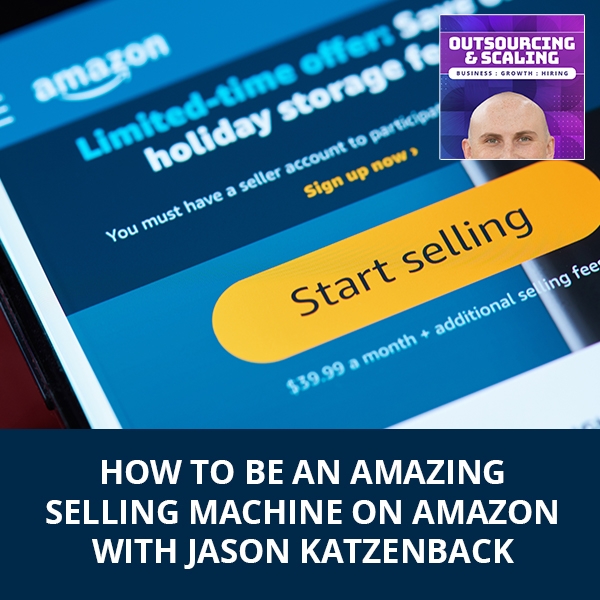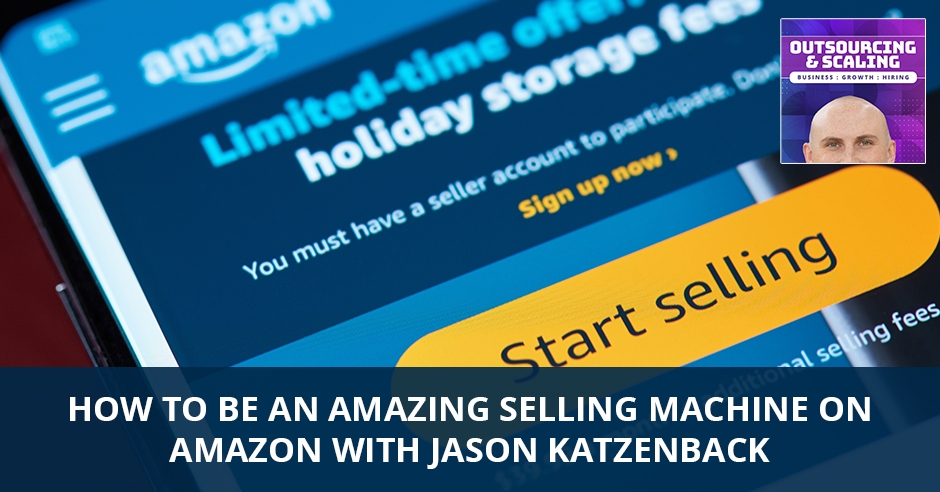


—
Listen to the podcast here:
[smart_track_player url=”https://www.podetize.com/statsapi/www.podetize.com/wp-content/uploads/fileuploads/11-5b145ef137b51b3d1af0633e9305c43d/07/2019/d590ae02aec4a25226fbf8357b912f49.mp3″ title=”How To Be An Amazing Selling Machine On Amazon with Jason Katzenback” artist=”Nathan Hirsch” image=”https://freeup.net/wp-content/uploads/2019/04/OAS.png” ]
Download the audio file here.
How To Be An Amazing Selling Machine On Amazon with Jason Katzenback
I’m here with Jason Katzenback. Jason, how are you doing?
I’m doing wonderful. Thank you very much.
For those of you that don’t know Jason is one of the Founders of Amazing.com teaching people how to sell on Amazon. We’re going to talk all about that. First, I want to take a gigantic step back. What were you like growing up as a kid? Were you a rebel? Were you a straight–A student? Did you know you wanted to be an entrepreneur?
I definitely wasn’t a rebel. I’ve always been a law–abiding person. For some reason, authority and I have always got along. It’s something registered in me. I always like to push my limits. For me, the moment I realized that I wanted to be something different was I couldn’t have been more than ten years old. We were going on an airplane with my parents, walking through first class and I’m asking them, “Why aren’t we sitting here?” My mom is laughing with these embarrassed giggles and saying, “We can’t afford it.” I was thinking, “Mom, you and dad worked 70 hours a day, obviously you’re doing something wrong.” At that moment, I said to myself, looking at them, looking at the people in first class and realizing, “They all have briefcases. I need to do something in life that has a briefcase.” At that moment, I realized working for a living wasn’t the solution. I had pointed at that time that I knew that I needed to do something different than what my parents were doing, but I didn’t know if that was going to be going up the corporate ladder or if that was going to be doing my own business.
Did you finish high school? Did you finish college?
I finished high school. I dropped out of college. I’ve always been one of those types of people that I have to learn hands-on. That’s how I’ve always taught people too is this is what I’m doing in my business. This is how I’m running things. This is why I recommend it. I can’t stand theory. For me, the theory is only good if I’m going to test it and share it. Other than that, you’ve got to be careful because sometimes people preach theory and people think, “This is what I should do,“ when they don’t know if it works. For example, running Facebook ads to products on Amazon. Many people are losing so much money trying to do that when it’s a completely different animal.

In theory, it works, but you’ve got to test that out. We’ve done lots of testing and what works well for some things definitely don’t work for others. You’ve got to be careful with that. With college, it was like, “I don’t get why I’m learning this stuff.” What happened is after I went into the work world, I started understanding how things connect that I went back to school and I got a 4.0. That’s how I’ve been. The interesting thing about that, let me sidebar. I found this when a lot of our students were going through the Amazing Selling Machine, learning how to start a business on Amazon, where they go through the motions when they’re first going through the course. They don’t send when they’re done and whether they’re going through Amazing Selling Machine or any other program out there.
It’s interesting to look at them and see how much of the process they missed. I always recommend people go through the course twice, go through the training twice because when you’re first going through something, you’re talking about branding, you’re talking about all this stuff. It‘s like, “Right now, my mindset is I’ve got to get a product up on Amazon, never mind branding.” It’s amazing how many times you’ll see people at the end of their journey. It’s like, “Your listing isn’t even optimized.” They go back to the training and now they’re understanding why they need to focus on these things in their listing optimization. That’s how I’ve been. I need to be hands–on learning that way. It’s not good for me to read a book and say, “I’ll do this now.“ It’s like, “No. I’ve got to be implementing it while I’m reading it.” That’s who I am.
What about after college? How did you first come across eCommerce? Was there anything in between that?
I was working for a company called Weyerhaeuser. When I was 23 years old, I remember sitting in this piece of equipment called a paint booth. It was an OSB manufacturing facility. I was sitting in this paint booths. It’s what they call down day at this period of time. We were doing maintenance on the machine. I was sitting there with paint halfway up my calves sitting in this big bucket of paint basically and putting my head down. I was saying, “Is this what I want to do the rest of my life?” At that point, it was this revelation. I remember it so quickly. That day I told everyone I was working with that I’d be their boss in five years because something had to change. They all laughed at me because I was a smart–ass kid and 23 years old. All of a sudden, they didn’t understand that I had a major moment in my life. Within three years I was all their boss instead of five. It was the power of mindset. After that, I was able to move to the States. I was originally in Canada, but with Weyerhaeuser, I moved to the United States. They’ve put me in a different position at a different mill with better and higher authority.
As I was sitting there working my butt off, all of a sudden in 2003, the CEO at the time, canceled all bonuses, eliminated bonuses from the company, more or less saying, “You should be happy to get your pay. That’s what you’re working for.” At that time, I was sitting there looking at all these people that put in their eight hours max. I was putting in all this extra effort. I realized this is not fair. A few months later in the company newsletter, we found out that the CEO got a $7.5 million stock option because he took away my bonuses. At that point, I realized going the corporate ladder wasn’t the right way. I started looking at the internet. I came across a gentleman named by John Reese, who was teaching these course Traffic Secrets. That pulled me in at that time as that’s where I decided that I would invest in going online. On December 12th, 2005, I quit my job. In 2006, I did $3 million online. It was a good transition for sure. I’ve been doing this for many years.
I got into Amazon in 2008. It’s a totally different landscape. Talk a little bit about what eCommerce and Amazon were like back then.
Make sure that you have quality content. You can’t build a business on hacks anymore.
It was simple in many ways where there weren’t these fancy algorithms. It was all straight input. You are getting clicks for so much cheaper. 2008, 2012, there was a lot of shifting going on. Google started coming out with penguins and different things like this for updates on their algorithms. Back in the day, you could sit there, write one article and publish it on twenty different sites and have twenty different listings for that keyword on Google. Amazon or Google said, “No, duplicate content isn’t good.” Now they only show as one or two versions of the article. People started using spinning where they use a computer–generated thing to have this content.
What’s happened since then, social media came in, Facebook came in. Our internet bandwidth started getting better. There were easier real–time interactions and poor quality content kept diminishing. Back in 2005, you could create a horrible website, have a big Google ad in the middle of it, AdWords or AdSense ad and drive traffic and you’d get your page rank. People would go on the page, not getting value. They click the ad and you make money. That was a way that people were making $50,000, $60,000, $100,000 a month. That was not offering a good experience. Right around 2008, that’s when user experience started mattering with a product.
I found that around 2008 which is interesting when you came on. It was transitioning to more social. Real–time content was becoming huge. Quality was becoming huge, but also the number of people shopping online was skyrocketing. Originally it was like, “You buy online. That’s scary. It’s risky,” to now, we’ve got that generation that’s changed. Everyone’s born with buying online. It’s so much bigger. The big focus has to be, at that time, I’d say quality. Making sure that you have quality content that you couldn’t build a business on hacks anymore. You couldn’t like a black hat as much as people still love doing that. It was like, that’s going to be a short–lived thing. You’ve got to get serious.
Finally, in 2011, I got on Amazon a few years after you did. It was this perfect transition for me because focusing so much on Google, doing affiliate and paid advertising, but I was always building somebody else’s brand, somebody else‘s business or somebody else’s product. All of a sudden when Amazon, I stumbled on that and realized, “I can do everything I’m doing, but now I have my own physical product that is a true physical product that I have an asset, a company, a brand name. I can do all these marketing things to build that up.” I dropped SEO like a bad habit at that time, affiliate marketing and all that. Now I still do obviously and that’s more from an influencer side. If there’s a product that I recommend, we have relationships with affiliate marketing, but back in the day, you’re basically pimping out any product that would pay you a commission. I feel like I went a little bit all over there.
No, it definitely did. You become an entrepreneur. You’re in the online space. You started Amazon business. Who was your first hire and how did that go?
My first hire was a customer support girl. She was good. She was with us for a few years until we switched gears and parted ways. One of the things I’ve always had and I’ve got people like Rich Henderson who was one of my first freelancers. Mike Krenitsky is one of my first freelancers too that are still with me. It took time, like so many people. You hire someone. For me one of the challenges with hiring is first of all, are you doing it out of passion and anxiety? What are you doing it out of? If it’s frustrated anxiety, you’ve got to stop and set back and say, “What are you hiring for?“

I know for myself at first you hire someone and it’s like, “I need you to do this stuff.“ They’re like, “What?” “I‘ve got to take the time to show you some.” Now you give it to them, “You’re going to do this right,” and all of a sudden, they’re messing up. You’re not checking in on them. You’ve got to stop for a second. If you’re hiring someone, this is a major business decision. This is a major business investment. If you’re willy–nilly hiring because you think it’s the thing to do or you’re frustrated and you need help, you’re going to get into trouble. It’s going to cost you more money. It’s not going to work out. What’s going to happen is you’re going to hire people, end up losing money in and say, “I don’t want to hire people anymore.“
What you need to do and I learned is when I hired these people, it was hired to replace what I was doing, not to do things that I wasn’t doing. I was major in customer support first. The two things I believed in right out of the gate is build a list and treat the customers exceptionally well. By treating the customers exceptionally well, that means I had to become part of the customer support system. I was answering customer support. It’s troubleshooting with people. If you’re going to scale your business and you’re going to grow your business, you can’t be in your business running it. You’ve got to be leading your business. What I started doing is hiring people to replace the positions that I was doing that I didn’t like, but I made sure that we had written out everything we needed to know about that role before we hired it out.
I’m not going to lie to you and say that we’ve done that for every position. Sometimes you are in the middle and it’s like you see all this stuff going and you do try to hire someone. Interesting enough, I guarantee you it’s been 80% of the time that those have not worked out. My first hire, I feel horrible I can’t remember her name. I feel bad about that. She’s a great freelancer too. We lucked out with her. Right away, she was one of the first people we hired and she was a phenomenal freelancer. How many programmers we went through, how many support people we went through? One of the biggest challenges I have is finding people that can keep up with how I talk.
I have a very different mind where I have to tell stories. I go around in this circle, it’s how my mind works. To me, I’m connecting all the dots and I always come back around to close the circle. However, for people that are listening to me, especially when I’m explaining a process that in my mind, they were looking at me like deer in headlights. When you find someone that all of a sudden get you, you protect that. You pay them more. You treat them well. You give them extra perks. That’s worked for me well. I’m surrounded right now with a loyal, powerful group of people and it’s very good.
Maintaining people that you love working with is so important. That turnover kills you. We were talking before and you said you use freelancers a lot. You also have freelancers in the US. How do you complement your US team with freelancers from all over the world?
First of all, you have to have good management. That was one thing that we’ve struggled with over the years is trying to move too fast but not having good management in place because everybody wants autonomy. Not everyone should have autonomy. Autonomy has different levels too. I don’t mean it that way. Oftentimes when we made a big mistake when we first opened our office and said like, “Your autonomy is come in when you want,“ and all those kinds of stuff. It’s like, “That’s why you don’t do this stuff.” We’re reading books about Google, Facebook, Amazon and all these things of how they run things. They have billions of dollars in VC-funded capital. They have all this extra stuff where they can hire the best managers, all this stuff to make sure that happens.
If you’re willy-nilly hiring because you think it’s the thing to do or you’re frustrated and need help, you’re going to get into trouble.
When you’re sitting there on a bootstrap budget trying to finance your own company, autonomy is extremely dangerous out of the gate. You’ve got to give them strict rules. You’ve got to give them strict guidelines. I look at it like the bumpers in a bowling game. There’s nothing wrong with that at first. Your goal is to get all those pins down. I don’t care at the end of the day if you use bumpers or not. You want to give them strict guidelines as you possibly can and follow up with them, always close the loop with them, “Where are you with this?” It’s your business. A huge word is due diligence. At the end of the day, there’s nobody else responsible for your business than you. Stop making excuses why it’s everyone else’s fault. You need to own your business. You need to be the one that you are the only reason this company’s going to succeed.
You’ve got to be able to lead it the proper way. When you’re hiring people, it’s such a critical rule. We‘ve gone completely worked from home as well. You couldn’t do that right away. Essentially now we’re using outsourcers for everything in a way. People are employees in the company, but we have management in place with KPIs that they have to follow. We hold all those people accountable. We have managers that manage the outsourcers so that they’re accountable. We treat them all like they’re freelancers in the company. We make sure that we understand what are the metrics that we’re fighting for, what does success look like, what does failure look like and how do we go from there?
If I could give anyone one huge step when you hire someone, the tough questions to ask are first of all, in 90 days, what does success look like if this person is successful? What does failure look like and what can go wrong? You want to ask those questions because the next question is, what do you do when things go wrong? The last thing you want to do is hire someone in 90 days and sitting there going, “I wonder if they’re achieving results.” Finally, now you’ve just spent 93 months paying someone’s salary, that hasn’t done anything. By addressing those issues right away, “Here we are at the 90-day mark, we started this, this, and this happened. This person is to be let go. You do it. You’ve got to fire fast and hire slow. It’s when someone comes in.
When I say fire fast, where you might’ve heard that before, I’m sure you have, but it’s not about you’re done. It’s about making sure that you understand. First of all, it isn’t this person’s fault. If I hire someone and I give them no direction, nothing whatsoever and they’re floundering trying stuff, that’s by me. It’s like I’m the owner. I need to make sure I’m setting everyone up for success. If I do hire this person and they’ve had all of this stuff, you look at it and say, “You’re not getting the results that I need.” You’ve got to make those decisions. It’s important to do that. Another important tip about hiring is to me performance versus culture.
When you hire someone and they’re a great rock star, but if they’re an ass, like if they’re someone that constantly is causing an issue, if they’re more dangerous, is a good freelancer, is a good performer with an attitude than a bad performer with the attitude. What happens is everyone else in the company starts looking at, “Look at this person. They’re smart. They must know what they’re talking about.” You want to be careful with that. It’s called the wealth chart. They’re basically a square in the line and in the middle, you’ve got performance. Up and down you’ve got more or fewer behaviors. It talks about if you’re low on performance, you can get coached to be better. If I’m saying, “You’re poor at writing this article,” let me teach you how to write this article better. If you’re a great article writer but you’re miserable, constantly causing issues, constantly causing drama, there’s no coaching for that. That’s who that person is. That’s what I believe in. I believe in everyone. Everyone can succeed. I want to give everyone a second chance.
Life and business are different. With businesses, this money is coming out of my pocket. I didn’t hire you. The job description did not say I will take nine months to turn you into a good performer. It’s like, “No, I’m hiring you to be an asset as soon as possible.“ You’ve got to get strict on those focuses. It’s like, “When I’m hiring this person, what does failure look like? What are we going to do if there’s a failure? What does success look like? What are we going to do if there’s a success and what’s a realistic timeline?” Sit with the person and make sure everything’s clear so there are no surprises on their end too. They’re not sitting there three months from now, “What? Why are you firing me? I didn’t know I was supposed to achieve these things.” It’s good communication.

Let talk about Amazon sellers. I know the Amazing Selling Machine has helped tons of sellers. You like helping sellers grow. Let’s talk about hiring for Amazon sellers. What do you recommend doing there? What should the Amazon seller do to scale their business?
The first thing you want to do is get a note pad. I don’t care if you want to use just a pad. I’ve got pads of paper all over the place. You’re constantly writing stuff down. You want to journal your activity. If you’re stating there like let’s say you’re running a business and there are different phases. Initially, you need to do as much as possible yourself because you need to understand what it is you’re doing. Once you’ve got some things going, you’ve got your product up on Amazon. You’re starting to ramp up. You want to figure out, “Am I running my business or leading my business?” If you don’t know the answer, the best thing to do is journal. You don’t have to journal forever.
What I recommend is two to three weeks and every day what you’re doing is put a little alarm on it. Every two hours when the alarm goes off, in bullet point, write what you focused on with how much time do you think you’ve focused on it. You can buy tools. You could do this every hour. You’re not going to do it every hour, even if you do it once a day. What happens is you have this list on your page and what you do is you go back over it with a highlighter. This is what I recommend. I pick a red highlighter and I highlight everything that is wasting money. My goal is to run $1 million a year business. Let’s say I’m someone starting out. I want to be generating $1 million a year.
That means that I have to be earning $3,300 a day for my business. That means the work I put in has to be equal to $3,300 a day in there. The way I’m trying to get you to think about it is this is your salary. That’s what you’re getting paid out. You need to be focusing on tasks that are essentially paying you about $400 an hour. If you’re doing $400 an hour test in your business, you’re focusing on the right thing. What are you focusing on? “I spent 50 minutes on Facebook,” red flag. I can’t be doing that. “I spent two hours trying to tweak an image that isn’t going to make a difference in my business.” Red flag that. You start identifying first of all the things that you need to cut.
Stop doing that crap. That stuff is going to destroy your business. What I do is I take my yellow highlighter and I start looking at the things that need to get done in the business, but I could pay someone minimum wage thing to be able to do it. Overseas, for $7 an hour, you can get some great talent to do a lot of those administrative daily things. Things like checking customer support, getting stats where you’re putting them into reports. Making sure every day your listing is audited so that there are no changes that customer reviews are replied to, that Amazon always has a response. You pick those things that it’s like, “This is something I can hire for $10 an hour.” I’m going to start making a list of all of these things that I’ve done over the last few weeks and segmenting them that, so now I’m creating a job.
I realize with what I’m focusing on, if I can get rid of this stuff, it’s going to save me two hours a day. That means I can hire someone. I haven’t booked two hours a day of work with me doing it. It’s probably going to take them twice as long at first. I’m going to budget to hire someone for four hours a day to do all this stuff for the next little bit. The idea is while they’re learning to do that stuff. After four hours a day, chances are within about a month, they’ll be doing it in about two hours a day. You’ll have identified more things to start putting on their plate. The big thing I recommend like whether it be any business, but specifically Amazon right now that we’re focusing on, is that you understand it.
At the end of the day, there’s nobody else responsible for your business than you. Stop making excuses why it’s everyone else’s fault.
Don’t think you can hire somebody and say, “I know I have to run sponsored ads so I’m going to hire someone to run them,” especially if it’s any paid advertising, that’s suicide. When you’re paying advertising and think you can hire someone to magically do it, that won’t work out. You want to also prioritize those things. You’re still learning as well that is get a free lap. I’ve got two hours extra a day. I can start focusing on a sponsored ad and start learning it. I can get to a point like now I understand sponsored ad, I can start hiring people to manage it because I know what to look for.
I’ve got one last question and I appreciate you coming on. Where do you see Amazon going? You see a lot of people saying that it’s getting saturated, that now is not a good time to get in. Let’s hear your thoughts on whether now is a good time to sell on Amazon.
You have to read stats. Go on Google and say Amazon growth, eCommerce growth, growth of people buying online, growth of Amazon share for eCommerce. Do yourself a favor and research those if you’re having any doubt that now is an awesome time to get on Amazon. There’s no doubt. When I first got on Amazon in 2012, within four months I was doing $200,000 a month, over $100,000 a month in profit because Doctor Oz suddenly started talking about raspberry ketone drops. I got in my first product with raspberry ketone drops so they exploded. It’s one of those stories that it’s like, “I was doing all these other things I get on Amazon. It explodes.” What it did for me at that time, it was a different item. Amazon was different.
It wasn’t easier because at the same time I was getting attacked day in and day out with fake reviews, hijackers on my products, those things. Now hijacking is a lot harder. Amazon has cleaned up things like that. There are a lot more products on Amazon. However, there are also way more people shopping on Amazon. When you started, they were doing like $20 billion. When I started, they were at $70 billion. Now they’re over $300 billion a year. That’s the revenue of people buying from Amazon. Amazon also has its other business. 60% of their income comes from product sales. A huge percentage of that comes from third–party sellers. More people are buying online. They say out of Millennials, 3% of Millennials do not use Amazon.
Imagine the next generation after Millennials, they’re growing up. Amazon is now a word for them. It’s a verb. It’s like, “Did you google that?” They know to go to Amazon. Amazon gives you one–day shipments and you think of it like every product you can buy is still not on Amazon. More and more people are going to Amazon and the number of people going to Amazon and the amount of options for you to be able to sell on Amazon is continuing to grow. What’s different about Amazon? Sometimes people get into the mindset of how Google works. If you’re not on page one, position one, you’re not winning. That’s not true at all. You could be the bottom of page one and still doing $30,000 a month on a product.
There are so many opportunities. For people that are saying, “It’s too late.” What is your option? I don’t understand that. You’ve got this platform that you can make millions of dollars selling on that’s proven over and over again, but you’re putting up all these roadblocks without even trying. Robert Kiyosaki, he was a big influence on me back when I first read his book, Rich Dad, Poor Dad. He can be a little blunt. He can say, “That’s loser talk.“ You’re being a loser if you think about that. I don’t like saying it like that, but at the same time, that’s how I feel. You get those odd people that all of a sudden say, “I don’t think it’s going to work that way. I’m going to do it this way.” They fail. You’re like, “Why do you put up these roadblocks? Don’t you follow a system?“

When people sign up, I would say, “Follow the system.” You’re investing this money. We’re proving. We’re putting our reputation online, follow the system and it will work for you. When you don’t follow the system, your question is why? When I look at people sitting there and saying, “It’s too risky.“ First of all, you’re probably not set up to be an entrepreneur because if you’re sitting there putting all these roadblocks up, being entrepreneurs, it’s a lot of work. Don’t get me wrong. I love the freedom. I can travel all over the world. I’m going to Europe for a full month. We’re a complete work from home company now. It’s absolutely phenomenal. It’s great that way. I work a lot of hours because I love it, but I’m passionate about it. You’re going to work a lot of hours.
The other thing is, as the owner of your company, you’re responsible for everything. That means that when you’re a manager, you’re responsible for your little section. You don’t make decisions that can bankrupt a whole company. As a business owner, you’re responsible for everything. If you’re terrified constantly of making any move because what if it’s a failure? It’s like that’s the whole point of being an entrepreneur. There’s a quote that I love, “Do the things now that others are afraid of so tomorrow you can do things others only dream of.” That’s what you’ve got to be like. With an entrepreneur, you’ve got to be able to face those fears.
You don’t want to be stupid about things obviously at the same time. When you look at Amazon, “Where’s your logic coming from? Where do you see that?” “There are too many people selling on Amazon.” Use that. “How many people are selling on Amazon? How many people are buying on Amazon? What are the options that I have here?” You’ll see Amazon is huge. There’s so much potential. In summary, for anyone asking that question, it’s ridiculous. Amazon is as good as any time to get started. In fact, a lot of ways it’s better because there are a lot more rules put in place. The only thing I want to remind people is there’s no such thing as a get rich quick thing. This is about building a real business.
You’re leveraging Amazon to be able to build your own brand of products. That’s something else to think about. This is never about building an Amazon business. It’s never about building this one business that relies totally on Amazon. It’s about building a brand. Where is the best place to sell your brand? Where’s the best place to launch your brand? It’s on Amazon because we know brick and mortar stores, it’s the apocalypse for them. They are closing left, right and center. If you build your own eCommerce store, good luck with trying to drive traffic to it and get people to notice it. When you start out on Amazon, you’re leveraging Amazon’s huge traffic, huge brand name, huge shopping cart, all of those kinds of things. It’s a better way to go. It’s a fantastic opportunity. We still have so many students all the time, thanking us all the time, hitting goals that they never dreamed they’d be able to.
Jason, thanks so much for coming on. Where can people find out more about you, find out more about Amazing? What are you most excited about for the rest of the year?
What I’m most excited about is SellerCon in Las Vegas at the MGM Grand. It is our big Amazon event. We’re going to have thousands of people there like John Mackey from Whole Foods, Dave Asprey from Bulletproof. We’ve got the CEO owner of Spanx. We’ve got Robert Kiyosaki going there. People like Ezra Firestone, Ryan Moran, tons and tons of top–level people. This is something I’m very proud of our students that have gone to SellerCon. To our students that haven’t, the SellerCon attendees of our students 250% more likely are to be between $1 million to $12 million a year. It attracts successful people. It shows that you’re into this game. I encourage you if you‘re an Amazon seller, checkout SellerCon. If you’re looking to start on Amazon, check out Amazing Selling Machine or check us out at Amazing.com, that’s our main company.
I really appreciate you coming on.
It’s awesome to be here.
Important Links:
About Jason Katzenback
 CEO and Co-Founder of Amazing.com, Jason is a serial entrepreneur and philanthropist, who since 2005 has generated over $120 million in sales in his own companies and has also been blessed to be able to have coached, mentored and taught tens of thousands of students on how to successfully create and run their own businesses.
CEO and Co-Founder of Amazing.com, Jason is a serial entrepreneur and philanthropist, who since 2005 has generated over $120 million in sales in his own companies and has also been blessed to be able to have coached, mentored and taught tens of thousands of students on how to successfully create and run their own businesses.
